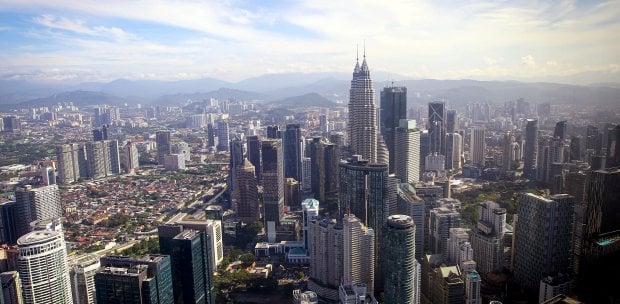KUALA LUMPUR: The Malaysian economy eased to 3.7 per cent in 2023, following strong growth registered in the previous year (2022: 8.7 per cent).
Growth moderated amid a challenging external environment, according to Bank Negara Malaysia (BNM).
The central bank said this was due mainly to slower global trade, the global tech downcycle, geopolitical tensions, and tighter monetary policies.
The Malaysian economy expanded by 3.0 per cent in the fourth quarter of 2023 (3Q 2023: 3.3 per cent; 2Q 2023: 2.9 per cent), according to BNM.
Household spending remained supported by improving labour market conditions and easing cost pressures.
The unemployment rate declined to the pre-pandemic level of 3.3 per cent while the labour force participation rate was at a historic high in 2023.
Meanwhile, growth in investment activity was underpinned by the progressive realisation of multi-year projects and capacity expansion by firms.
Exports, however, remained subdued due to prolonged weakness in external demand amid stronger imports.
On the supply side, there was a broad-based expansion.
The commodities sector grew, supported by higher oil and gas production as well as expansion in the agriculture sector amid improved labour supply.
The services and construction sectors continued to expand. The manufacturing sector remained soft due to continued weakness in the electrical and electronics industries. In terms of monthly gross domestic product.
December recorded a growth of 1.4 per cent, lower than November (3.8 per cent) and October (3.9 per cent), attributed mainly to the shorter school holiday period during the month and the weaker export-oriented manufacturing sector.
On a quarter-on-quarter seasonally-adjusted basis, the economy contracted by 2.1 per cent (3Q 2023: +2.6 per cent).
On the domestic front, despite the lapse of large policy support provided as the economy started to open up in 2022, the continued recovery in economic activity and labour market conditions supported growth in 2023.
In addition, the solid growth performance of the economy is reinforced by a resilient external position.
Despite the challenging external environment, the current account surplus for the year 2023 was sustained at 1.2 per cent of GDP, supported by a diversified export structure across markets and products.
The strength in the external position is also reflected in the external debt, which declined to 68.2 per cent of GDP in 2023 (3Q 2023: 69 per cent), and a higher net international investment position at 6.6 per cent of GDP in 2023 (3Q 2023: 5.2 per cent).
Importantly, the external debt remains manageable given the favourable maturity and currency profiles.
One-third of the external debt is denominated in ringgit, limiting currency risk, while around 70 per cent of debt has medium- and longer-term tenures.
Foreign currency borrowings are also subject to BNM's prudential requirements and continue to consist mainly of concessionary intragroup loans.
Headline inflation continued to decline to 1.6 per cent during the quarter (3Q 2023: 2 per cent The downward trend was contributed by the moderation in fresh food inflation (4Q 2023: 0.5 per cent; 3Q 2023: 1.9 per cent) and core inflation (2 per cent; 3Q 2023: 2.5 per cent).
The lower core inflation was largely driven by an easing in services sub-segments, including food away from home and repair and maintenance of personal transport.
Inflation pervasiveness continued to trend lower, as the share of Consumer Price Index items recording monthly price increases moderated to 36.3 per cent during the quarter (3Q 2023: 40.8 per cent).
This brought inflation pervasiveness below its fourth quarter long-term average (2011–2019) of 41.7 per cent.
For 2023 as a whole, headline inflation declined to 2.5 per cent (2022: 3.3 per cent) while core inflation averaged 3.0 per cent (2022: 3 per cent).
Domestic financial markets continued to be driven by evolving financial market expectations over the global monetary policy path.
In particular, participants in the financial market believed that the US policy rate had already peaked and that the US Federal Reserve would start reducing the policy rate in 2024 amid the ongoing disinflation.
Against this backdrop, the ringgit appreciated by 2.1 per cent against the US dollar in the fourth quarter of 2023, in line with regional currencies following a broad based depreciation in the US dollar.
Malaysia's external position also remains supportive of inflows. BNM will continue to ensure sufficient liquidity to support the orderly functioning of the domestic foreign exchange market.
Financing conditions, credit to the private non-financial sector expanded by 4.7 per cent (3Q 2023: 4.3 per cent), driven by higher growth in business loans (3.6 per cent; 3Q 2023: 1.9 per cent) while outstanding corporate bond growth moderated to 4.2 per cent (3Q 2023: 5 per cent).
The higher business loan growth was driven mainly by higher growth in working capital loans.
Of note, SME loan growth remained forthcoming (8.2 per cent; 3Q 2023: 7 per cent).
For households, outstanding loan growth remained steady at 5.6 per cent (3Q 2023: 5.4 per cent), reflecting sustained growth across key purposes.
Moving forward, Malaysia's growth will improve due to resilient domestic expenditure and a recovery in external demand growth in 2024, which will be driven by resilient domestic expenditure and an improvement in external demand.
On the external front, the IMF is projecting a rebound in global trade growth from 0.4 per cent in 2023 to 3.3 per cent in 2024.
Together with the tech upcycle, stronger external demand and continued improvement in the tourism sector will provide support to Malaysia's exports.
On the domestic front, household spending will be supported by continued employment and wage growth.
Investment activity will be underpinned by the further progress of multi-year projects, by both the private and public sectors, as well as the implementation of catalytic initiatives under the various national master plans. Improvements in tourist arrivals and spending are expected to continue.
The growth outlook remains subject to downside risks stemming from weaker-than-expected external demand and larger declines in commodity production.
Nonetheless, there are upside risks to growth emanating from greater spillover from the tech upcycle, stronger-than-expected tourism activity, and faster implementation of existing and new projects.





